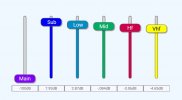Hi, my loudness solution is a bit complicated to implement, but very easy to use. Most folks will probably think it's a bit nuts ...
It's for use with multi-way actives, and dsp.
For each driver section; sub, low, mid, high, and vhf; there is a separate volume control. Along with a master volume control for all.
So the frequency response can be set to flat, or whatever, much like using a multiband equalizer.

Each driver section covers roughly 2 octaves, which in a sense equates to a 5 band equalizer.
The difference between my setup and an equalizer, is that opposed to lifting the equalizer frequency's center with whatever bandwidth or Q chosen, my setup lifts the entire passband up without any taper across the bandwidth. Iow, it's not like a parametric lifting like a mountain top, but it's like lifting the entire plateau. It works this way because xovers are steep linear phase, which also keeps phase flat across the spectrum, allowing relative large level changes.
It's the easiest way to adjust for Fletcher-Munson i've found, especially given a wide range of SPLs, and different listening environments.
(Best room in my house is outdoors, and loud

)
It's also the easiest way to simultaneously adjust for the vast tonal differences in tracks stemming from Toole's well described 'circle-of-confusion'. Fletcher-Munson aside, this method has greatly increased pleasure from tracks that clearly had recording studio tonal imbalances a long way off from flat.
The 5 volume sliders, along with the master slider, are like a numerical combination padlock......
it's amazing at whatever level listening, even low, that a certain combination sounds, well..... Bingo!
It all came about by accident, building and tuning multi-way DIYS. During design, it's needed that each driver be able to be controlled and processed individually. I used to ditch the individual controls after full system tuning, but luckily, i tried leaving them in once to play around.
They're here to stay!


